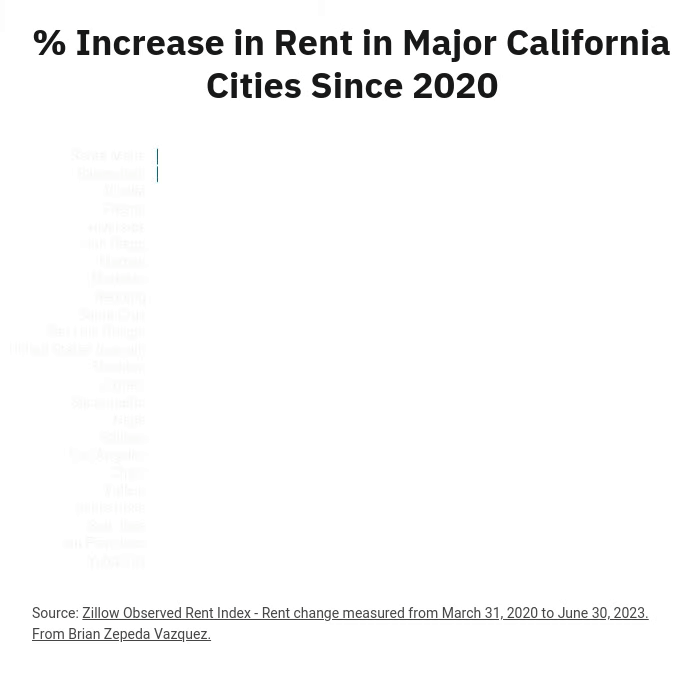Despite national increases in teacher pay, inflation (or a general increase in prices that reduces the amount one can afford) has actually decreased teachers’ purchasing power by 5.3% over the past 10 years. And, even though California has the highest average teacher pay in the country, 52% of school districts in California are located in areas where the starting teacher salary cannot afford that area’s most common rent prices without becoming rent-burdened (which means spending over 30% of their income on rent).
Balancing Rent Prices
Take a look at Norton teachers’ salaries versus rent prices. The median rent in San Bernardino is $1,943, and the starting monthly salary for a Norton teacher before taxes (without a Master’s degree) is $5,596.75. That median rent is $69 below the United States’ median rent, yet still accounts for 34% of a Norton teacher’s starting salary–a rent-burdened proportion of monthly income.
However, many Norton teachers live in surrounding cities (e.g., Redlands, Riverside, Ontario, Rancho Cucamonga) where rent is much higher. Ontario’s median rent, for example, is $2,871, $928 more than the median San Bernardino rent and 51% of a Norton teacher’s starting salary.
Eighth-grade English teacher Kimberly Llamas, who lives in Ontario, shares her qualms about high rent prices.
“A one-bedroom apartment is like $2,500,” Llamas said, “That’s not including electricity, not including paying gas for the house. Everyone wants to move out when they’re 18, right? And I did that. But when I was 18, the prices weren’t the same anymore.”
Llamas’ frustrations are not unfounded. California’s Inland Empire has seen a significant rise in rent prices since the COVID-19 pandemic in 2020, despite being historically considered a cheaper place to live than California’s major cities. Riverside, for example, saw a 37.5% rent increase from 2020 to 2023.

“Who wants to live with their mom at 25?” Llamas continued. “I love my mom, and it is very normalized in Mexican culture to live with your parents for a long time. But I want to become independent and have my own life.”
Eighth-grade science teacher Stephanie Deininger expressed her concern for her students and their families, too.
“I know that I’ve got students whose families have had to move in with other family members,” Deininger said. “They have nowhere else to go.”
Saving for Retirement
Yet, those previous money estimates leave out key investments that teachers must make, such as paycheck withholdings for retirement. For instance, CalSTRS, the public pension fund for California teachers, requires teachers to contribute 8% to 10.25% of their earnings to their STRS retirement account. That would equal, at minimum, several hundred additional dollars out of a teacher’s paycheck, shrinking the amount of income left to use for current personal and family expenses.
Sixth-grade English teacher, Raquel Garcia, shares how much she spent saving for retirement to catch up with the amount she needs later in life.
“I used to contribute like $700 per paycheck,” Garcia said. “It was a lot to CalSTRS because I felt so behind. I started my career later in life, and I was trying to catch up. But due to inflation, I had to lower it down to like $300 per paycheck instead.”
Saving for Children’s College
That picture, though, looks a lot worse for families. According to MIT’s Living Wage Calculator, a family of two working adults with two children should earn a before-tax income of $119,715. If only one adult in that family can work, they should earn a before-tax income of $93,616. In other words, it would take at least 11 years moving up the salary schedule for one working Norton teacher providing for a family with two children to make a living wage.
“I get about $2,100 a paycheck, or $4,200 a month,” Garcia said. “Luckily our household is dual income and we only have one child. Without our second income, it would be a lot harder to afford everything for our family.”
But the MIT Living Wage Calculator does not specifically account for saving for children’s college either. It is commonly recommended that parents save at least $300 per month for each child for attending a four-year, in-state public college or university. For a 529 savings plan in California, a monthly $300 contribution would equate to $92,421 by the time the child is 18 years old.
However, $92,421 is far less than what is needed for all required costs to attend a four-year, in-state public college or university in California. Off-campus housing and food alone for University of California and California State University campuses is estimated to cost anywhere from $11,644 (like Chico State) to $21,508 per year (like UC Berkeley). Using those two campuses as an example, the estimated cost to attend Chico State for four years is $113,752 and for UC Berkeley is $167,328. To save for those campuses’ estimated four-year costs using a 529 plan (or stocks that grow by an amount equivalent to 6% compound interest), one would need to save about $400-$550 per month for each child (equivalent to $4,800-$6,600 per year).
Garcia shares that saving money for her children’s college is a challenge, but that she has started using an investment app called Acorn to invest little-by-little in stocks.
“Whatever purchase I make, the app rounds up the money,” Garcia said, “Currently, in that account, I think I have like $5,000. And it just keeps growing and gets invested into the stock market.”
Paying for Gas
Gas has also become more expensive. California’s average gas prices increased from $3.56 a gallon in 2018 to $4.68 this November.
Deininger noted how dramatically gas prices have changed over her lifetime thanks to inflation.
“I remember paying less than $1 a gallon for gasoline,” Deininger said. “Now it’s really close to $5.”
In other words, to fill a 12-gallon tank it used to be only about $12 in the 1990s and $24 in the 2000s. Now that California’s average gas price fluctuates around $4-5 per gallon, it costs, on average, around $50-60 to fill up.
“My tank is about 16 gallons, $4 a gallon. So it’s like around $60 to fill up my tank,” Llamas added. “And I have to come to work, right? So I’m going back and forth from Ontario to San Bernardino, then using my car to drive outside of work, too. It adds up. I spend like $200 a month on gas alone.”
Paying for Food and Groceries
Even basic necessities like food from the grocery store have gotten significantly more expensive. In fact, food prices have increased by 20% over the past four years, and many Americans cited food inflation specifically as their top inflation-related worry.
“When I was in high school, we could go to places like Del Taco,” Deininger said. “We actually could leave school for lunch, and Del Taco had a menu of things that were like 29 cents or 39 cents.”
“I am an AVID teacher, too. And we used to sell sodas after-school to fundraise,” Llamas added. “Now that prices have increased we can no longer make a profit by selling those same sodas for a dollar.”
Student Activities Clerk, high school cheer coach, and dance teacher Brenda Cornejo also shared how food prices have impacted her family.
“We’ve done more Costco shopping than we used to before,” Cornejo said. “We used to just run to Ralphs or Albertsons, and now we go to Stater Brothers or Food for 4 Less or Costco instead because of the cost. Milk and eggs are things that have especially gotten more expensive since covid.”
Splurging on Travel and Recreation
Travel and recreation are things teachers have cut back on, too.
“We still do trips at least once to twice a year, but we’ve had to budget more than we have in the previous years because of it,” Deininger said. “I haven’t been to Disneyland or Magic Mountain in years just because it’s so expensive. It’s just not worth it to me.”
“I will have to change my shopping habits when I move into a new apartment,” Llamas explained. “I won’t be able to go and just get my nails done all the time now because it adds up. I used to love going out with my friends. We would go to LA in the middle of the night and hang out. And we don’t do that anymore because gas is way too expensive.”
Final Thoughts
“We’ve had to change brands to more affordable options. And sometimes my son will ask for things,” Garcia said, “But we don’t really need it. So I have to put my son down gently and make do with what we have.”
Without recent salary increases Norton teachers struggle to balance the wants and needs of themselves and their families. More inflation has meant less for those that make education possible.




